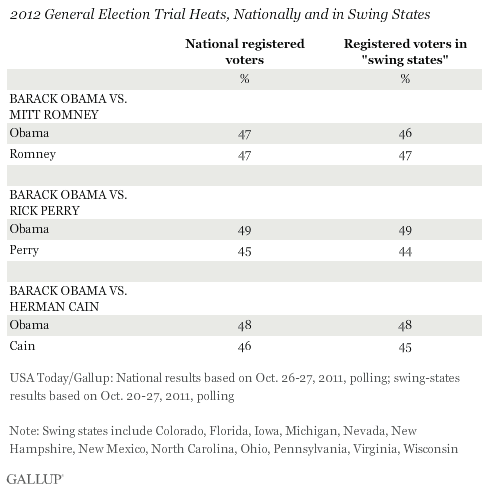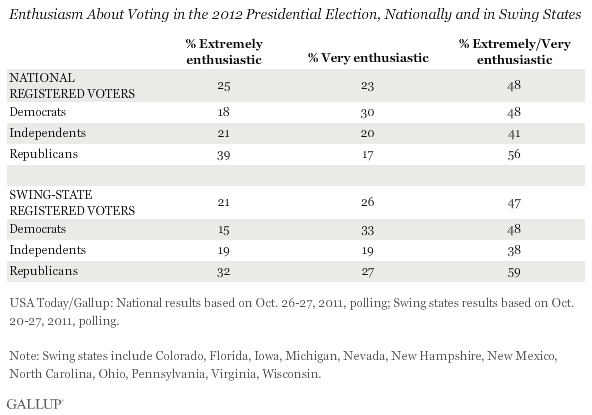PRINCETON, NJ -- Registered voters nationally and in 12 key swing states are evenly divided in their preferences for president in the 2012 election between President Barack Obama and Republican Mitt Romney. Romney is at least somewhat more competitive versus Obama than either Rick Perry or Herman Cain, in polling conducted before the recent allegations of sexual harassment against Cain surfaced.

The "swing state" results are from the initial USA Today/Gallup Swing States poll, based on Oct. 20-27 Gallup Daily tracking in 12 states that will be among the most crucial to winning the 2012 presidential election. The states include Colorado, Florida, Iowa, Michigan, Nevada, New Hampshire, New Mexico, North Carolina, Ohio, Pennsylvania, Virginia, and Wisconsin. USA Today and Gallup will report on voters' preferences in this group of states at least monthly leading up to the 2012 election.
The comparison national presidential trial-heat results reported above are based on Gallup Daily tracking Oct. 26-27. These are similar to what Gallup measured nationally earlier this year. Romney and Obama were essentially tied in Gallup's September presidential trial heat update, with Obama having a slight edge versus Perry. This is Gallup's first measurement of Obama versus Cain. In general, these trial heats are more favorable to Obama than Gallup's measure of Obama versus a generic Republican, which generally shows Obama trailing.
Voting Enthusiasm Higher Among Republicans in Swing States
Although swing states historically receive the most attention from the presidential campaigns, registered voters in these 12 states at this point are no more likely to be enthusiastic about voting in the 2012 election than are voters nationally. Currently, 47% of swing-state registered voters and 48% of all U.S. registered voters say they are extremely or very enthusiastic about voting.
Republican voters are more likely to express enthusiasm about voting, both nationally and in the swing states. On the national level, 56% of Republican registered voters and 48% of Democratic voters are extremely or very enthusiastic about voting. In the 12 swing states, the Republican advantage in enthusiasm is 59% to 48%.
There is a wider partisan gap in favor of the Republican Party among the most enthusiastic voters -- those who say they are extremely enthusiastic -- in the swing states and among the broader U.S. voting population.

The Republican advantage in enthusiasm may be greater currently because of the apparent vulnerability of Obama, whose approval rating remains in the low 40% range. Gallup asked the same question in early 2008 -- when George W. Bush had 34% job approval -- and Democrats were more likely to be enthusiastic. In the 2004 election, which resulted in a narrow win for Bush, Republicans and Democrats were about equally enthusiastic on this measure.
Implications
A year before the 2012 presidential election, the contest is shaping up to be a competitive one -- both nationally and in the key swing states. How competitive the contest ultimately will be partly depends on whom the Republicans nominate to challenge Obama. Currently, Romney seems to be a slightly stronger challenger than either Perry or Cain.
Perceptions of the economy's direction are also likely to be a key factor, especially in the swing states.
With so much attention likely to be concentrated on voters in these 12 key swing states, they may be more susceptible to influence from the campaigns than voters in other states. Gallup and USA Today will continue to report on the trends in voter sentiments in these states, as well as nationally, leading up to the presidential election.
Survey Methods
Results for swing state residents are based on telephone interviews conducted Oct. 20-27, 2011, on the Gallup Daily tracking survey, with a random sample of 1,334 adults, aged 18 and older, living in Colorado, Florida, Iowa, Michigan, Nevada, New Hampshire, New Mexico, North Carolina, Ohio, Pennsylvania, Virginia, and Wisconsin, selected using random-digit dial sampling.
For results based on the total sample of "swing state" residents, one can say with 95% confidence that the maximum margin of error is ±3 percentage points.
For results based on the total sample of 1,169 registered voters in swing states, one can say with 95% confidence that the maximum margin of error is ±4 percentage points.
The data represent a subset of Gallup's national daily tracking survey for Oct. 20-27, and are proportionate to population size of each state. Samples are weighted by gender, age, race, Hispanic ethnicity, education, region, adults in the household, and phone status (cell phone only/landline only/both, having an unlisted landline number, and cell phone mostly). Demographic weighting targets are based on the March 2010 Current Population Survey figures for the aged 18 and older non-institutionalized population living in telephone households in the 12 swing states. All reported margins of sampling error include the computed design effects for weighting and sample design.
The weighted and unweighted sample sizes for each state are shown here:
|
|
Unweighted |
Weighted |
Weighted |
|
|
|
|
|
|
Colorado |
94 |
81 |
6 |
|
Florida |
192 |
257 |
19 |
|
Iowa |
64 |
50 |
4 |
|
Michigan |
126 |
147 |
11 |
|
Nevada |
35 |
38 |
3 |
|
New Hampshire |
27 |
22 |
2 |
|
New Mexico |
38 |
29 |
2 |
|
North Carolina |
128 |
132 |
10 |
|
Ohio |
151 |
169 |
13 |
|
Pennsylvania |
245 |
204 |
15 |
|
Virginia |
130 |
115 |
9 |
|
Wisconsin |
104 |
90 |
7 |
Results for the national sample are based on telephone interviews conducted Oct. 26-27, 2011, on the Gallup Daily tracking survey, with a random sample of 1,056 adults, aged 18 and older, living in all 50 U.S. states and the District of Columbia.
For results based on the total sample of national adults, one can say with 95% confidence that the maximum margin of sampling error is ±4 percentage points.
Interviews are conducted with respondents on landline telephones and cellular phones, with interviews conducted in Spanish for respondents who are primarily Spanish-speaking. Each sample includes a minimum quota of 400 cell phone respondents and 600 landline respondents per 1,000 national adults, with additional minimum quotas among landline respondents by region. Landline telephone numbers are chosen at random among listed telephone numbers. Cell phone numbers are selected using random-digit-dial methods. Landline respondents are chosen at random within each household on the basis of which member had the most recent birthday.
Samples are weighted by gender, age, race, Hispanic ethnicity, education, region, adults in the household, and phone status (cell phone only/landline only/both, cell phone mostly, and having an unlisted landline number). Demographic weighting targets are based on the March 2010 Current Population Survey figures for the aged 18 and older non-institutionalized population living in U.S. telephone households. All reported margins of sampling error include the computed design effects for weighting and sample design.
In addition to sampling error, question wording and practical difficulties in conducting surveys can introduce error or bias into the findings of public opinion polls.
View methodology, full question results, and trend data.
For more details on Gallup's polling methodology, visit www.gallup.com.
